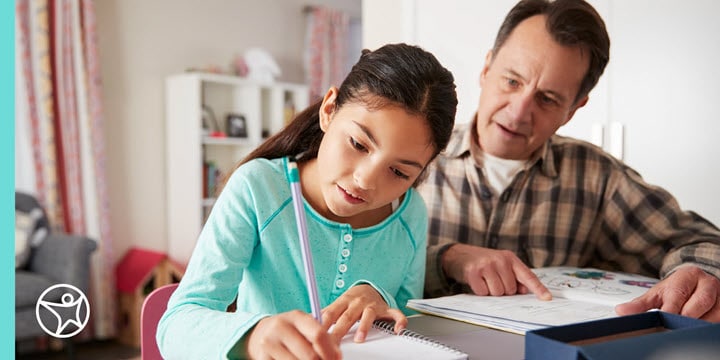5 Ways to Teach Students About Juneteenth
by Connections Academy
byChristopher E. Nelson
6 min to readAs you and Connections Academy® work together to help your student grow into a well-rounded, resourceful, and resilient individual, the physical foundation of your online school experience is your home classroom.
With the first day of online school for your K–12 child(ren) just around the corner, it’s a good time to take a look at what belongs in a homeschool classroom. Here is how to create a virtual classroom for your child in seven easy steps:
First, you’ll need a dedicated, organized space to serve as your homeschool classroom. Not everyone can dedicate a whole room—such as a spare bedroom—to schoolwork. Even if you have limited space for your homeschool setup, you want your student to feel ownership and become comfortable with the routine of “going to school” in a specific place.
When choosing a desk for your child, consider one with adjustable legs, so it will fit your child for several years. The typical classroom desk height for students in fourth grade and above is 30 inches (measured from ground to desktop). For smaller kids, the desk should adjust down to at least 22–24 inches.
If your child will be working from a table that has other duties, consider a desk riser, which can be moved from the table when necessary. Desk risers are a lighter and less expensive type of standing desk, which can remain collapsed for seated use. Older students might appreciate (and be able to safely operate) a desk riser to stand as they work from time to time.
Comfort is a big consideration, because your child will be spending a good amount of time in this chair. There are several features available with desk chairs for students:
But as with a desk, proper chair size is paramount. The appropriate size for a kid’s homeschool classroom desk chair will depend primarily on the child’s height and weight. A child’s desk chair should:
Make sure your child’s homeschool setup is properly lighted. Good lighting requires good lightbulbs, and it can improve attention span, accuracy, and productivity.
Once you have chosen the lightbulb that works best for your family, let’s look into lamps. A desk lamp, table lamp, or nearby floor lamp can all provide good task lighting for reading, writing, or viewing a computer screen.
Whether desktop, laptop, or mobile, the computer screens that Connections Academy students and Learning Coaches choose to work from need to meet Connections Academy hardware, software, and connectivity requirements. Don’t forget a power strip to keep everything running, and consider a universal charging station to recharge several mobile devices simultaneously.
Not all home-schooling is on a computer screen. To sketch out ideas for your online student, you’ll want the generous space that a traditional chalkboard or dry-erase white board can provide. A cork bulletin board can provide a place to pin up:
A magnetic board with colorful letter- and number-shaped magnets is a great teaching aid for younger, virtual school students.
These types of boards can be hung, mounted, or can be freestanding, and are found at any office supply store. Be sure you know the measurements of your wall or floor space you have available before buying.
As you hang these boards up and design your homeschool classroom, check out these common learning environment set up mistakes to avoid.
And because not everything in your homeschool classroom will always live on a screen, board, or desktop, you’ll need storage space. You can obtain or adapt:
These, too, are readily available from office supply stores or retailers specializing in storage and organization supplies.
As you add these pieces and others to your virtual classroom, keep the overall aesthetics of the space in mind. Let your child help decide how their school room will be decorated. Consider, too, that colors affect mood. Color psychology studies have concluded that certain classroom colors are more conducive to learning.
The standard advice is that proper ergonomics for sitting at a desk—including correct chair height, adequate equipment spacing, and good desk posture—can help keep your child pain-free and content (if not happy). But, as Meredith Chandler, an occupational therapist with the Ergonomics Health Association, writes, “Very few children will purposefully sit in a strict 90-90-90 position in school all day, because they are built for movement.”
There are proper ergonomic considerations for children when they sit and work, but Chandler says kids should also be allowed to move around during the day as long as it does not interrupt academic learning. Learning Coaches should design their student’s online school schedules to include daily educational activities that get their students out of their chairs.
Chandler says experts promote active sitting to combat the dangers of lengthy static sitting for children as well as adults. Active sitting, also known as “dynamic sitting,” refers to actively engaging core muscle groups, even for micro-movements, while stationary. This can be done with:
There are right and wrong ways of setting up technology. Here are some additional ergonomic desk setup tips on how to get ready for online school:
Monitors should be close enough to the child’s body, so the student doesn’t have to squint or lean forward to see what’s on the screen.
Keyboards should have angular adjustments and padding, so wrists are neutrally positioned (straight) while typing.
The keyboard and mouse should be at a desktop height, so the angle of the elbows is 90 degrees or slightly more.
Sturdy footrests can promote changing foot positions, which will increase circulation in the legs and prevent dangling of the feet while working.
Once you’ve finished your child’s homeschool setup, it’s time to review what should be on your back-to-school shopping list in preparation for the first day of virtual school.
Check out more ideas for helping kids start their online learning adventures successfully by visiting the Connections Academy’s tips and resources page for families.
by Connections Academy
by Cassandra Polzin
by Dan Belenky
